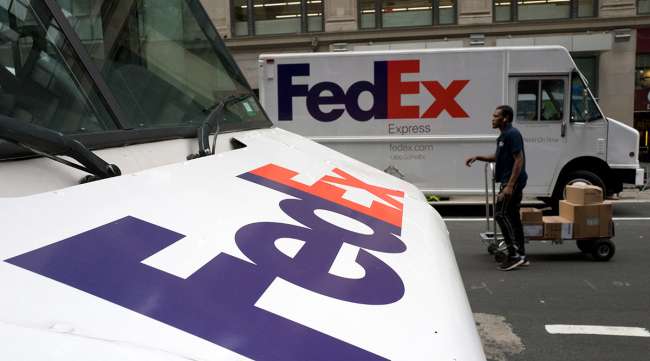FedEx Reports Solid Quarter, Expands Walmart Deal

FedEx Corp. turned in steady results for its fiscal third quarter ending Feb. 28, with income benefiting from the U.S. Tax Cuts and Jobs Act enacted in December, along with solid returns from its FedEx Ground division.
The Memphis-based package delivery giant also announced it would add 500 office locations in Walmart Inc. stores over the next two years, following a recent test at 47 outlets. The Walmart partnership is in line with the opening since last year of FedEx pickup and drop-off services at thousands of Walgreens Co. drugstores.
For the quarter, FedEx reported net income of $2.1 billion, or $7.59 earnings per share, compared with $562 million, or $2.07 a share, in the same period in 2017. Adjusted for one-time items, the company reported earnings per share of $3.72.
Revenues were $16.5 billion, up from $15 billion a year ago, and just under analyst expectations of $16.6 billion.
Net results include a total tax benefit of $1.53 billion, or $5.60 a share, arising from the tax reform bill. The company spelled out three primary components to the benefit, including $1.2 billion for a re-measurement of the company’s U.S. tax liability, a benefit of $200 million from a pension contribution made in February, and a benefit of about $170 million to the phase-in of the reduced tax rate applied to year-to-date earnings.
FedEx CEO Fred Smith told analysts during a conference call that the company is concerned about the tariffs on imported steel and aluminum announced by President Donald Trump in March.

Smith
“[History] has shown repeatedly that protectionism is counterproductive to economic growth. The better approach is to encourage open markets and free exchange of products and services and to reduce barriers to trade,” Smith said.
The FedEx Ground segment reported operating income of $634 million, a 23% increase from last year, on revenue of $5.2 billion, up 23% from $4.7 billion a year ago. The growth was attributable to higher base rates and an average daily package volume growth of 6%, much of that due to surging e-commerce volume, Executive Vice President Alan Graf told analysts. The segment was challenged by increased purchased transportation, seasonal staffing and network expansion costs, he said.

Graf
The FedEx Express segment reported operating income of $424 million, a 24% drop from $557 million in third quarter 2017, on revenues of $9.4 billion, up 9% from $8.6 billion.
The FedEx Freight segment reported operating income of $55 million, up 34%, on revenues of $1.7 billion, a 14% increase from a year ago. Revenues rose due to less-than-truckload revenue per shipment growth of 8% and average daily LTL shipment growth of 6%.
The company’s total average daily package volume fell 1% to 6.1 million, while the composite package yield was $18.45, up 8% from $17.06.
FedEx reported its total U.S. overnight package volume fell 1% to 1.8 million, and its total U.S. domestic package numbers were flat at 2.9 million.
The yield, or revenue per package, on its U.S. overnight composite of envelopes and packages rose 6% to $19.74, and the yield on its U.S. domestic composite rose 5% to $18.29.
The firm’s total average daily freight pounds, U.S. and international, rose 3% to 29.2 million. The composite revenue per freight pound rose 7% to $1.02 from 95 cents.
FedEx ranks No. 2 on the Transport Topics Top 100 list of the largest for-hire companies in North America.




